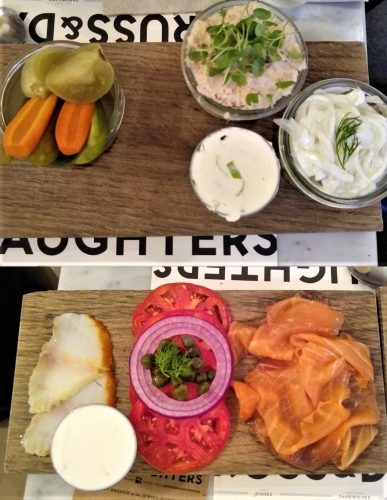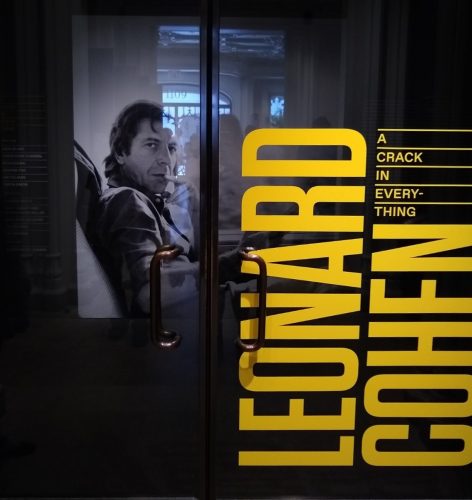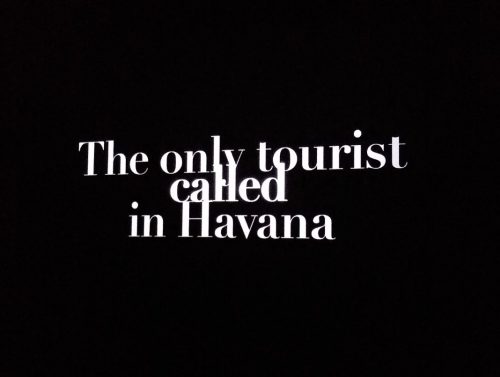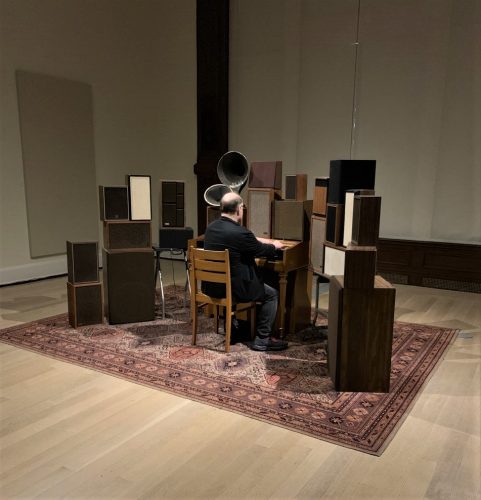Autumn in New York

From Visitor Services Coordinator Talia Makowsky. To read more posts from Talia, click here.
Earlier in September, my mom asked me to visit her in New York as a birthday present to her. Glad for the opportunity to visit a couple museums there, and unable to say no to my mother, I took the train up for the weekend. We enjoyed good food, a great concert by her favorite musician, and had a chance to visit the Jewish Museum in New York.
The main feature of the visit was the special Leonard Cohen exhibit, which closed on Sunday, September 8th. But before we could explore this tribute to the artist’s life, we needed breakfast. And on a Saturday morning in New York, we wanted a classic Jewish brunch.
Polish immigrant, Joel Russ, arrived in Manhattan in 1905. Bringing Polish flavors and foods to the Jewish community already established in New York, Russ worked his way up from selling herring from a push chart, to opening a storefront called J Russ Appetizers in 1914. Appetizer foods are known to the Jewish communities as “food typically eaten with bagels”, such as smoked salmon or lox, homemade salads, and cream cheeses. Appetizers would sell dairy meals and fish. This sets Russ’ store apart from our local Attman’s, as delis were known for selling cured and pickled meats.
Russ’ business grew, and he moved the store to 179 East Houston Street in 1920 where it remains to this day. With all the extra work to be done, his three daughters were enlisted to help out, as Russ had no sons to run the business. In 1935, he made his daughters his full partners in the business and renamed the store “Russ & Daughters”, the first US business to have “& Daughters” in its name.

As the business evolved and family members took turns running it, they were able to expand in 2014 by opening a Russ & Daughters Café. Their expansion continued in 2015, when Russ & Daughters opened at the Jewish Museum in New York.
This particular location is situated in the basement of the Museum, and they offer pre-paid reservations for Saturday mornings, to support visitors who observe Shabbat. This way, people who observe Shabbat would not have to handle money, which is forbidden because it’s considered work. Russ & Daughter’s Shabbat prix-fixe menu included a fresh salad, deviled eggs, a breadbasket of freshly baked treats, a board of cream cheese and smoked fish, and ended with halvah ice cream and chocolate babkah.
It was a delicious taste of New York Jewish culture, and a satisfying way to begin our visit to the Museum.

With full bellies, my mom and I set off to explore three floors of galleries dedicated to the Leonard Cohen exhibit.
“I just set out to write what I felt as honestly as I could, and I am delighted when other people feel a part of themselves in the music.” – Cohen in an interview in the Los Angeles Times, 9/24/1995.
Leonard Cohen situated himself in words. His novels, books of poems, and many song lyrics speak to a man dedicated to the composition and power of words. Cohen’s works also express a man who grappled with questions of spirituality, social issues, sensuality and love, and the end of life. The exhibit that was on display at the Jewish Museum, organized by the Musée d’art contemporain de Montréal, featured performances and works by Cohen, but was made up of videos, installations, and objects created by other artists, mixing Cohen’s rich source material into experimental presentations.


The other artists chose different ways to play with Cohen’s work. One room on the second floor was a large, open space, with an old-fashioned organ situated in the middle. The organ was connected to several vintage speakers. As a visitor presses on the keys of the organ, Cohen’s voice rings outs, reading poems from his Book of Longing. Each key corresponds to a different poem, and so playing one after another can lead to the creation of a new poem, out of Cohen’s lines. Playing more than one key causes multiple recordings to play, allowing Cohen’s voice to fill the space.

This exhibit was fun to experiment with, and it was especially interesting to watch people interact with the work. One visitor simply listened to one of the poems read, pressing down on only one key. Another visitor played line after line, creating their own poetic verse. I practiced pressing down on multiple keys to get the full experience, and was joined by another visitor, playing the other end of the organ, causing multiple readings to jumble up as Cohen’s words overlapped. The room filled with Cohen’s voice, immersing the people inside in his work, though the words were hard to distinguish in the noise.
There were plenty more ways that the exhibit played tribute to Cohen’s works. A humming machine played the song ”Hallelujah”, Cohen’s self-portraits were projected across a screen, and a blank room streamed his music while people could lounge on bean bag chairs and listen. All across the Museum, I saw people connecting with his words, their eyes closed or welling with tears, talking to their friends about the works, or standing silently in awe. The exhibit was immersive and unconventional, just like Cohen’s music. If you want to find out more about the exhibit, visit the Jewish Museum in New York’s exhibit page here. If you want to get a bit of the experience yourself, watch the video here.
Visiting as a museum professional, I found myself watching other people’s experiences of the exhibit, seeing how they connected with the content. I hope to bring these reflections, as well as future inspiration from visiting other museums, to the JMM, to help improve the experience of our guests, and challenge their own immersion into the exhibits.

1 reply on “Autumn in New York”
I was there the day after you for my second visit to this rich and extensive exhibit. Thank you for sharing your take on it. I’m so happy I was able to partake.